�

�
There's Soupability in GM's Aluminum V8's
� ��
as published in British V8 Magazine, Volume XVI Issue 1, May 2008�
�
Re-printed unedited from "Speed Mechanics" magazine. This article originally appeared in August, 1961.�
�
by Alex Walordy�
�
�
Buick and Olds were the first, this year, to come through with all new aluminum engines of�
advanced design. While the 215 cubic inch displacement and 3.50 by 2.80 bore and stroke are �
common to both versions, there are some sharp differences in appearance, cylinder head and �
manifold design that makes each engine stand out. �
�
The most striking advantages from a user's point of view, are the remarkable low weight of �
these powerplants, just 318 pounds, for an output of 150 horsepower at 4,400 rpm on the Olds �
and 155 horsepower on the Buick. This is power obtained from a stock engine, fitted with a �
single two-barrel carburetor, so that the possibilities are largely untapped. The present�
two-pounds-per-horsepower ratio will no doubt move down to a pound-and-a-half per-horsepower,�
or even less, as normal development takes place.�
�
Design with aluminum is different than with cast iron, and offers several manufacturing possibilities.�
Sand casting, with sand cores and patterns is one and follows the same methods as are now �
used in pouring cast iron blocks. A number of castings can be made from a single permanent mold, �
with the added advantage of superior finish and closer tolerances. Die casting makes use of �
pressure-injected molten aluminum poured into special dies. While its initial steps are �
comparitively costly, the long die life helps balance out costs.�
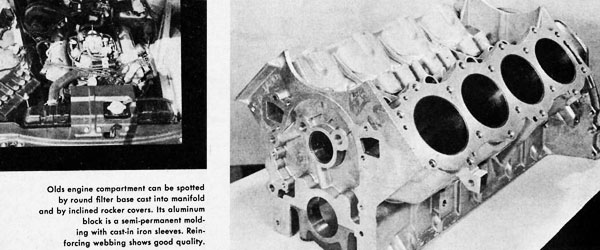
� Olds engine compartment can be spotted by round filter base cast into manifold and by inclined rocker covers.
� Its aluminum block is a semi-permanent molding with cast-in iron sleeves. Reinforcing webbing shows good quality. �
�
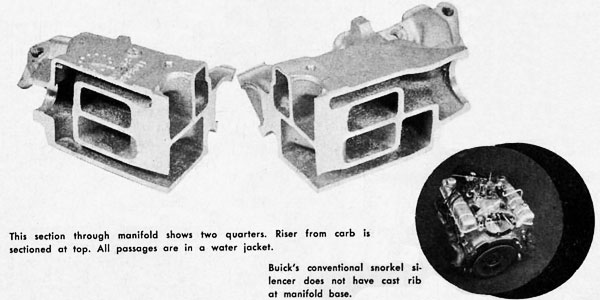
� This section through manifold shows two quarters. Riser from carb is sectioned at top. All passages are in a
� water jacket. Buick's conventional snorkle silencer does not have cast rib at manifold base.�
�
Die casting, being an automatic process, requires a direct withdrawal of the dies as the casting �
is completed. This has, so far, made it impractical to cast a block with a full cylinder deck.�
Instead, the cylinders are left standing free, tied in only at the bottom of the block. This �
poses sealing problems that will no doubt be solved shortly, but as yet this is not the most �
desireable solution. A wet sleeve design, where the cylinder liners are removeable, makes �
die casting very practical, but this method is too expensive for passenger car use, by Detroit �
passenger car standards. �
�
Buick and Oldsmobile hoped for a semi-permanent mold casting, with cast-in iron sleeves. �
Semi-permanent means the use of a combination of permanent molds for the outside of the �
block and the outside of the tappet valley, while sand cores are used for the water jackets �
and the inner bulkheads. There are high-silicone aluminum alloys that would allow direct�
use of pistons and rings against the aluminum. On the other hand, these alloys are expensive,�
and more difficult to machine than the alloy selected for the 215 inch block. �
�
To insure good cylinder life, centrifugally cast iron sleeves are used. It should be added that �
this type of sleeve allows closer selection and control of desireable wear characteristics than �
even a normal cast iron block, as the sleeves are relieved of the need for carrying great�
structural loads.�
�
An eight pitch thread cut .005 to .015 inches into the outsides of the cylinder liners retains �
them in the block after the aluminum is poured. Even though aluminum expands more than cast �
iron, the sleeves never become loose because they are closer to the heat source and because �
there is an unavoidable heat barrier at the junction of the sleeves with the block.�
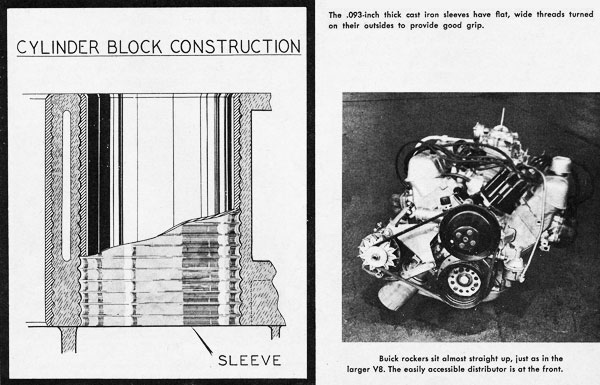
� The .093-inch thick cast iron sleeves have flat, wide threads turned on their outsides to provide good grip.
� Buick rockers sit almost straight up, just as in the larger V8. The easily accessible distributor is at the front.�
� The crank is a conventional cast alloy iron unit, fully counter-balanced, with large journals� and a 3/4-inch overlap between mains and rod journals. The main bearing diameter is set at � 2.2986 inches and width is .802 inches except at the number three main which takes up end thrust� and is .821 inches wide. A hefty rubber-mounted vibration damper testifies to the care used in � making the first aluminum engine a smooth running one. Deep skirts on the sides of the block� extend beyond the of the main bearing caps, contributing to rigidity and good crankshaft � support. The main bearing caps are made of cast iron. �
��
Enjoying this article? Our magazine is funded through the generous support of readers like you!
�
To contribute to our operating budget, please click here and follow the instructions.
�
(Suggested contribution is twenty bucks per year. Feel free to give more!)�
� The short stroke presently used (2.80), can probably be extended to three or 3.25 inches to offer � a displacement of 230 or 250 cubic inches. Incidentally, this is the only possibility of increasing � displacement on this engine, as the dry liners in the block are only 0.93 inches thick and will � not allow boring beyond .030 oversize, a meager gain at best. �
�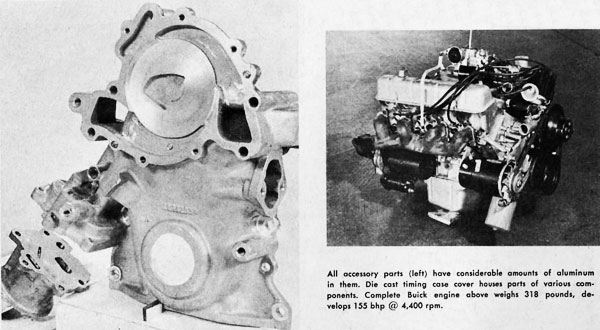
� All accessory parts (left) have considerable amounts of aluminum in them. Die cast timing case cover houses
� parts of various components. Complete Buick engine weighes 318 pounds, develops 155 bhp at 4,400 rpm.�
�
The diecast timing case cover accurately locates the rope-type oil seal at the front of the crankshaft. �
A protrusion around the seal and an effective slinger keep most of the oil away from the seal,�
reducing the amount of fluid they must control. In addition, a ridge cast into the inside of �
the of the timing case cover acts as a roof over the seal, and further contributes to keeping�
most of the oil away from it. The timing case cover also serves as the fuel pump mounting and �
as the housing for the oil pump. While Oldsmobile uses an optional oil filter, Buick carries �
the oil filter as standard equipment. When the filter is used, it replaces a large size plug�
at the bottom of the housing.�
�
The forged rods are quite short (5.660 inches center-to-center) and light (17.5 ounces).�
Wristpins are pressed into the rod and float in the piston. This eliminates the need for �
wristpin retainers in the piston or rod bushings. As in good aircraft practice, the wristpin �
is very thick to avoid rod deflection under load. �
�
The pistons are all aluminum, without expansion control inserts. The conventional slots are �
placed between the skirt and the head of the piston at the bottom ring groove, forming a �
heat dam and leaving the head tied to the skirt only in the areas above the wristpin bosses. �
When the top of the piston warms up, it expands equally in all radial directions. At the �
points where it is tied to the skirt, a hoop effect takes place with the skirt being pushed �
outward at the wristpin bosses and, therefore, pulling in at the thrust faces.�
�
The cam-ground piston is narrower across the wristpin bores than at the thrust faces. When �
the piston expands in the bore, the thrust faces are pulled inward. Slap at the thrust faces �
is controlled whether the piston is hot or cold. In customary strut designs, a steel strut �
is put to work accelerating, or amplifying, the hoop motion. In Buick and Oldsmobile's �
all-aluminum piston, the stiffness of the webs which tie the piston crown to the wristpin �
bosses is balanced against the stiffness of the skirt, itself, to achieve the needed hoop �
action. �
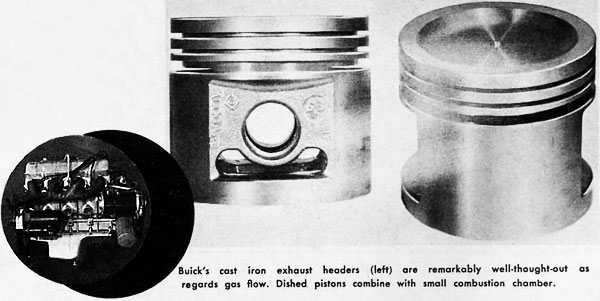
� Buick's cast iron exhaust headers (left) are remarkably well-thought-out as regards gas flow.
� Dished (Buick) pistons combine with small combustion chamber.�
� The bottom of the piston skirt forms a full hoop. Buick feels that this is stronger than � slipper piston designs of equivalent weight and helps control the action of the piston � in the cylinder. Two large size slots separate the bottom of the piston skirt from wristpin� bosses. This avoids skirt distortion and any restraining action which the skirt may have on � the pin bosses. If you consider a wristpin as a beam which is supported in the middle and � loaded at the ends, some deflection becomes inevitable. The best solution for retaining� maximum bearing area at the pins is to let the bosses flex with the pin. �
�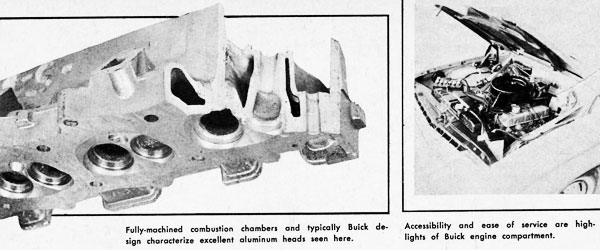
� Fully machined combustion chambers and typical Buick design characterize excellent aluminum heads seen here.
� Accessibility and ease of service are highlights of Buick engine compartment. �
�
Buick and Olds differ drastically in combustion chamber design. Olds has a wedge type �
chamber, flat top pistons, and a port configuration which largely resembles that of the �
larger Olds engine. Buick has a machined chamber of comparatively small volume and �
dished pistons. The valves on the Olds are angled to line up with the slant roof of the �
combustion chamber. On the Buick, they are placed almost straight up, and the port design�
is of course closely akin to that of the larger Buick engine. Even valve cover placements�
are distinctively those of their larger engine counterparts. �
�
Buick claims a more favorable surface to volume ratio at combustion time, together with �
a central plug location and very short flame travel through the major portion of the �
compressed air fuel mass. The squish area is distributed all around the piston and �
combustion chamber, creating a favorable turbulence. These dished pistons are quite �
reminiscent of those which enabled GM Research to run some very interesting tests at �
compression ratios ranging from 10:1 all the way to 25:1, or six points higher than with �
most diesels. �
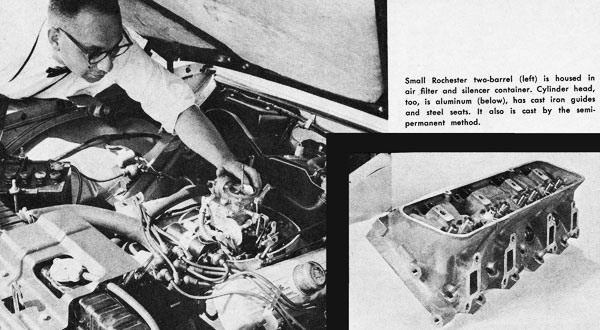
� Small Rochester two-barrel (left) is housed in (Olds) air filter and silencer container. Cylinder head, too is
� aluminum (below), has cast iron guides and steel seats. It also is cast by the semi-permanent method. �
�
The use of a dished section makes compression changes quite simple, and we might add that �
the use of a flat Olds piston in a Buick 215 would result in a compression ratio of 11:1. �
Where a dish is very deep and falls below the ring belt, some distortion can occur at �
operating temperatures and added heat is transferred to the piston. However, here the �
dish is so shallow as to have no practical effect.�
�
Engine cooling is quite elaborate. The aluminum water pump is bolted to the die cast timing �
case cover which also serves as the back of the impeller housing. Each of the two headers�
cast within the timing case cover leads directly to the corresponding cylinder bank. The coolant �
flows through the banks and up to the rear of the heads. After reaching the front of the �
heads, the coolant is then directed through the manifold to the radiator. �
�
To insure quick and even warmup, the coolant must first course from front to rear along the �
underside of the manifold risers, then reverse its flow and pass over the top of the risers �
before returning to the radiator. The use of water as the source of manifold heat eliminates �
an exhaust crossover, exhaust gas corrosion and a heat riser valve that traditionally rattles �
and sticks. �
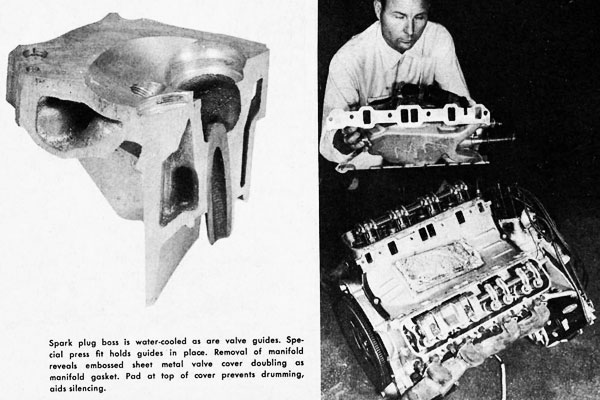
� Spark plug boss is water cooled, as are valve guides. Special press fit holds guides in place. Removal of manifold reveals
� embossed sheet metal valve cover doubling as manifold gasket. Pad at top of cover prevents drumming, aids silencing. �
�
Block water jackets extend the full length of ring travel, plus a good 1/4 inch. The spark �
plug bosses are completely surrounded by coolant. Decks at the head and block are almost entirely �
closed, except for an opening at the rear of the block. As the heads are interchangeable from �
side to side, symmetrical openings are used front and rear. Thus, all of the coolant is directed �
through the block and head. �
�
The slanted portion of each cylinder bank being partially above the openings at the rear, �
some venting is needed to avoid trapping air pockets during filling. Here again, we come to �
a difference between Buick and Olds. Olds uses four quarter-inch "steam holes" to vent the �
upper part of the block. "Steam hole" is actually a misnomer, for they are only vents. Buick �
on the other hand, found the four holes unnecessary and uses only one small one at the front �
of each bank.�
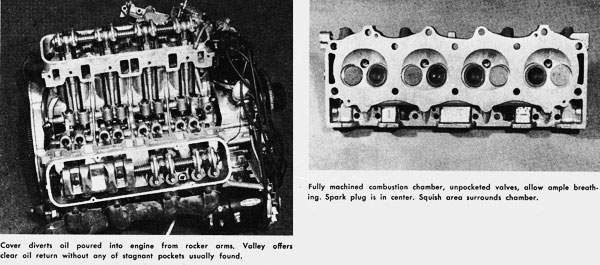
� Cover diverts oil poured into engine from rocker arms. Valley offers clear oil return without any stagnent pockets
� usually found. Fully machined (Buick) combustion chamber, unpocketed valves, allow ample breathing.
� Spark plug is in center. Squish area surrounds chamber.�
�
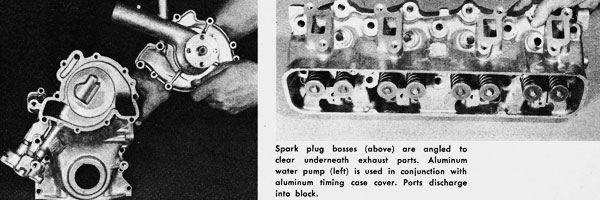
� Spark plug bosses (above) are angled to clear underneath exhaust ports. Aluminum water pump (left) is used
� in conjunction with aluminum timing case cover. Ports discharge into block. �
�
As you notice, the cooling systems use aluminum almost exclusively, except for the embossed �
steel gaskets. Hence the possibility of galvanic corrosion is considerably reduced. We asked�
specifically about special anti-freeze and were told by Buick that there were no plans or call �
for any at the present. The use of aluminum, with its high thermal conductivity, in the large�
cylinder block and head areas has enabled radiator size to be scaled down an appreciable �
amount in comparison to the area needed for equivalent cast iron engines of the same power.�
�
The blocks are fully leak tested when partially machined, and again when completed. If the �
leakage exceeds specified rates, they are impregnated. Over that, they are scrapped. Impregnation �
of both pressure and non-pressure types is used. Dry sealant pellets are added as a purely �
precautionary measure. �
�
The cylinder heads use copper-infiltrated, sintered iron inserts on both intake and exhaust �
valve seats. Valve guides are cast iron, pressed into the heads. Although no drastic improvement �
has resulted from use of aluminum as cylinder head material, there is a slight gain in mechanical �
octanes and a reduction of, or elimination of, potential hot spots. A rocker arm shaft rather �
than GM's favored ball socket arrangement is used. Part of the reason is that the pushrods are �
offset. Also, it would be difficult to retain rocker studs in the head by press-fitting them, �
and threads would be too expensive both in production and in assembly. Full gallery oil pressure�
is supplied to the rocker shaft through passages in the block head and a rocker shaft bolt. �
The openings for oil supply to the individual rockers are moved out of the load area to �
increase flow.�
�
The camshaft is cast iron, and has fairly mild timing. A sintered iron cam keyed on the �
camshaft operates the fuel pump. Hydraulic lifters are used as standard equipment, and �
the differences in expansion between steel and aluminum may well make them essential for �
noise reasons. The tappet valley is covered by an embossed steel section that also serves �
as the intake manifold gasket. By relieving the manifold of duty as a valley cover, much �
webbing between the risers can be eliminated with resultant weight savings. A foil-covered �
insulation bag laced between the manifold and the embossed cover eliminates noise and drumming. �
�
Oldsmobile manifolds have cast-in bases for air filters, which increase the silencer volumes �
and are claimed to reduce noise. Buick uses a snorkel-type air cleaner and eliminates some �
of the manifold complexity. Our trained ear couldn't detect any appreciable difference between�
the two. �
�
The advent of the aluminum engine will not only herald a new era in engine weight reduction, �
but also the building of many specials which, until now, had to be on the ponderous side. �
A saving in weight cannot be estimated on the basis of weight difference with an equivalent �
cast iron unit. There are also attendant weight savings in frame structure, drive train �
size, etc. These new Buick and Olds engines will undoubtedly influence the future of the �
automotive industry. �
� If you enjoyed this article, check out: Autocar Magazine's : � History of the Buick / Rover Aluminum V8.
�
�

